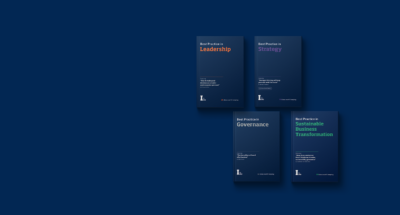
Best Practice book series for business leaders
Four books bring together the best I by IMD articles on leadership, strategy, governance, and sustainable business transformation. ...

by Bettina Büchel, Dominik Chahabadi Published August 11, 2021 in Strategy • 7 min read
In strategy formulation and execution, most organizations face a similar dilemma: how to develop a strategy and execute it to ensure value creation?
Against disruptive growth and fast-changing markets, accelerated strategy execution has become vital – all the more so when technology and disruptive innovation open ever more doors to new strategic possibilities.
That has challenged the dominant assumption that boundaries between industries are relatively stable, allowing businesses time to adjust to change. Empirical research, leading to publications such as Your Strategy needs a Strategy (Reeves et al., 2015) or The Essence of Strategy Is Now How to Change (Hunsaker & Knowles, 2020) now demonstrate the credo is invalid.
Businesses are addressing the shift through changes in the C-Suite. While the role of Chief Strategy Officer has flourished in the past two decades, ever more organizations are making space for the Chief Transformation Officer. Often, this function is created to look beyond strategy formulation to enhance execution in business transformation. That is paramount where an organizational set-up falls short in coping with a vast number of strategic initiatives happening in parallel at different levels and cutting across traditional divisional or functional boundaries.
But what are the choices to reinforce strategy formulation and execution? And how should the operating model look?
We turned to strategy practitioners across industries and geographies, and relevant academic research, analyzing different organizational structures for strategy development and identifying parameters influencing them.
The most pertinent parameters were consolidated in a framework diagnosing Industry Dynamics, Strategy Development as is, and then deriving Choices (ISC). Each component includes secondary parameters dependent on the organization’s business ecosystem. Together, the information allows one to select the right strategy operating and governance model (see chart).
Consider the framework like setting a curser on each parameter’s continuum. Working through the ISC framework in order will help identify the ideal position of the “curser” for your operating model.

Start by asking how stable your industry environment is? The options include a classical, adaptive, visionary, or shaping type of strategy (ref. to Reeves et al. 2015).
Certainty of industry environment
Influence on Industry Structure
Speed of industry dynamics
Implications of your analysis:
Strategies need to be adapted fast to react to competitive moves, innovation speed or changing customer demands.
2: Strategy Development Assessment: what is your approach to strategizing?
The next step is to assess your strategy approach. What is your strategic time horizon (short vs. long-term planning) and what is the appropriate strategy approach? We also distinguish between two axes: strategy making (i.e., deliberate strategic planning vs. emergent and agile processes) and engagement (i.e., top-down vs. bottom-up processes). Both axes have significant impact on deriving the operating model for strategy enablement.
Strategic Time Horizon
Ambidexterity of Strategy
Strategy Making
Engagement Process
Implications of your analysis:
3: Choice of Operating Model for Strategy Office: how should your operating model of strategy development and transformation look?
The final step is a reflection and assessment on the role and operating model of the strategy office. By now, you should have a clear idea about the strategy development process for your organization and be able to evaluate which operating model best suits the strategy office. Three flexible elements should guide the design.
Strategic Growth
Strategic Activity
Role of the Strategy officer
Implications of your analysis:
We recently conducted this test on a fertilizer company, whose strategy approach (based on a one-size-fits-all view and long-term time horizon) needed adapting. It was apparent that the existing operating model for strategy enablement was no longer effective to achieve growth ambitions. This was mainly due to the significant differences in industry context between the core business – phosphate and standard fertilizer – and the growth business – customized fertilizer, feeds – which required profoundly different strategy approaches and development. Applying the ISC framework identified a new operating model for the strategy office, leading to a newly defined role for the strategy officer. The latter function was combined with chief transformation officer to ensure responsibility for both strategy formulation and execution. Building strong capabilities in facilitating strategy formulation and assisting the different businesses with change management and execution will make the company more competitive and accelerate growth.
Creating a more transformational function for the strategy office also brings benefits in change management:

Professor of Strategy and Organization at IMD
Bettina Büchel was a Professor of Strategy and Organization at IMD. Her research topics include strategy implementation, new business development, strategic alliances, and change management. She was a former Program Director of the Strategy Execution and Change Management open programs, as well as teaching on the flagship Orchestrating Winning Performance (OWP) program.
Transformation and Learning Manager at IMD
Dominik Chahabadi is Transformation and Learning Manager at IMD.

21 hours ago in Strategy
Four books bring together the best I by IMD articles on leadership, strategy, governance, and sustainable business transformation. ...

December 1, 2025 • by Julia Binder, Knut Haanaes in Strategy
In the second episode of IMD’s sustainability series, IMD's Julia Binder and Knut Haanaes welcome Kunal Chandra of RWE to discuss the energy transition....

November 26, 2025 • by Milda Mitkute in Strategy
From clearing out her wardrobe to building Lithuania’s first tech unicorn, Vinted founder Milda Mitkute reflects on what it takes to grow responsibly...

November 24, 2025 in Strategy
Professor Amar Bhidé challenges AI hype, arguing that LLMs flatter rather than enlighten and that executives must distinguish calculable risk from true uncertainty....
Explore first person business intelligence from top minds curated for a global executive audience